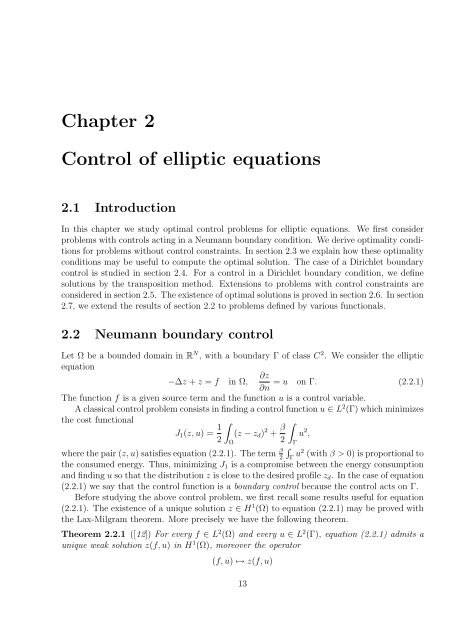Optimal Control of Partial Differential Equations
Optimal Control of Partial Differential Equations
Optimal Control of Partial Differential Equations
Create successful ePaper yourself
Turn your PDF publications into a flip-book with our unique Google optimized e-Paper software.
Chapter 2<br />
<strong>Control</strong> <strong>of</strong> elliptic equations<br />
2.1 Introduction<br />
In this chapter we study optimal control problems for elliptic equations. We first consider<br />
problems with controls acting in a Neumann boundary condition. We derive optimality conditions<br />
for problems without control constraints. In section 2.3 we explain how these optimality<br />
conditions may be useful to compute the optimal solution. The case <strong>of</strong> a Dirichlet boundary<br />
control is studied in section 2.4. For a control in a Dirichlet boundary condition, we define<br />
solutions by the transposition method. Extensions to problems with control constraints are<br />
considered in section 2.5. The existence <strong>of</strong> optimal solutions is proved in section 2.6. In section<br />
2.7, we extend the results <strong>of</strong> section 2.2 to problems defined by various functionals.<br />
2.2 Neumann boundary control<br />
Let Ω be a bounded domain in RN , with a boundary Γ <strong>of</strong> class C2 . We consider the elliptic<br />
equation<br />
∂z<br />
−∆z + z = f in Ω, = u on Γ. (2.2.1)<br />
∂n<br />
The function f is a given source term and the function u is a control variable.<br />
A classical control problem consists in finding a control function u ∈ L2 (Γ) which minimizes<br />
the cost functional<br />
J1(z, u) = 1<br />
<br />
(z − zd)<br />
2 Ω<br />
2 + β<br />
<br />
u<br />
2 Γ<br />
2 ,<br />
where the pair (z, u) satisfies equation (2.2.1). The term β <br />
2 Γ u2 (with β > 0) is proportional to<br />
the consumed energy. Thus, minimizing J1 is a compromise between the energy consumption<br />
and finding u so that the distribution z is close to the desired pr<strong>of</strong>ile zd. In the case <strong>of</strong> equation<br />
(2.2.1) we say that the control function is a boundary control because the control acts on Γ.<br />
Before studying the above control problem, we first recall some results useful for equation<br />
(2.2.1). The existence <strong>of</strong> a unique solution z ∈ H1 (Ω) to equation (2.2.1) may be proved with<br />
the Lax-Milgram theorem. More precisely we have the following theorem.<br />
Theorem 2.2.1 ([12]) For every f ∈ L 2 (Ω) and every u ∈ L 2 (Γ), equation (2.2.1) admits a<br />
unique weak solution z(f, u) in H 1 (Ω), moreover the operator<br />
(f, u) ↦→ z(f, u)<br />
13

















